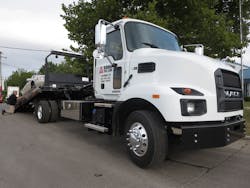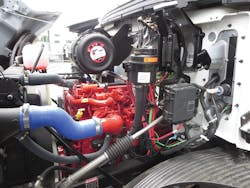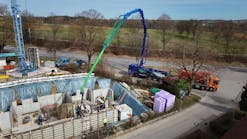In late summer of 2019, I was on the way to a family gathering in Wisconsin when my car broke down on Interstate 69 in northeastern Indiana. The idler pulley popped loose, throwing the serpentine belt and leaving the engine ram-air cooled only. I pulled off at the next exit, parked, and called AAA. Sooner than I expected, up rolled a well-worn, bright-yellow early ’90s International with a roll-back body, whose owner-driver quickly winched my 20-year-old Lincoln Continental aboard. Then he hauled the car and me into Auburn, where I sought repairs and holed up for the night. I went to Wisconsin and back with a rental car.
A year later, it was almost déjà vu as my 21-year-old Lincoln moved onto another roll-back flatbed, but this time under its own power. It provided a realistic load for my drive of the new Mack MD6 truck chassis. This was at McMahon Truck Centers, a Mack and Volvo dealer in Columbus, Ohio. Tightening the tie-downs and pulling the Jerr-Dan’s control levers was Paul Blackston, vocational segment manager, who went along for the test drive. McMahon is also a Jerr-Dan dealer and sells ready-to-work tow trucks on Chevy, Ford, and Hino chassis, and the medium-duty Mack truck was a new product for him and the dealership.
View other truck and equipment evaluations.
Mack Trucks has gone into and out of medium-duty trucks several times since the 1930s, and in the ’80s and ’90s it did so with low-cab-forward models obtained from European owners and modified for North America. It returned in 2020 with a conventional-cab Mack truck more attuned to the wants of most buyers here. Traditionally, 85 percent of midrange truck customers choose a conventional over a cabover. Mack workers assemble them from American parts in a dedicated plant in the Roanoke Valley of Virginia, not far from sister company Volvo’s heavy-truck plant in Dublin. The MD series is among many domestic and imported models competing for medium-duty business, but it differs from some of them by offering a midrange truck with big truck feel.
Front and rear axles and suspensions together could carry 29,000 pounds, but the truck is rated at under 26,000. The MD Mack truck seems to sit taller than most other mediums, and its galvanized steel cab is suitably roomy, especially in width. But the truck is compact, with a 103-inch bumper-to-back-of-cab dimension and a tight turning radius. The cab, adapted from Mack highway tractors, seems to sit high for a midrange truck, and the adjacent hood slopes upward to meet the cowl. Put another way, it slopes downward to allow the driver a good view of the road. The Mack bulldog ornament and the hood’s leading edge are visible, and the chrome dog makes a good aiming sight on narrow streets and roads; if the dog is at the edge, the wheels are still on the pavement.
The well-sealed door slammed with a reassuring thunk! Instruments, switches, and controls were on a pair of oblong dashboard panels to the driver’s front and right. The steering wheel had no switches—something I prefer. Spoke-mounted switches are usually low, requiring drivers to take their eyes off the road and peer at them until they learn what does what, and maybe operate them by feel. In the MD, all switches are on the dash. As on most Class 8 heavy trucks from Mack, the MD steering wheel’s rim is flat at the bottom, giving a bit of extra room for one’s thighs while sliding in and out of the cab.
With Blackston riding shotgun, I ventured onto the streets and freeways of the Buckeye State’s capital city. At freeway speeds, the ride was rather quiet and smooth, with the multi-leaf front and rear suspensions doing a nice job of soaking up bumps. Visibility in all directions was very good. The truck had Meritor S-cam air brakes, and they were strong and well balanced.
The 300-horsepower B6.7 diesel engine spun busily as it’s meant to; its red line is 2,600 rpm. Cruising at freeway speeds had it revving at 1,700 rpm or so, thanks to the rear axle’s 4.69 ratio and even with the 6-speed Allison’s overdrive ratios in 5th and 6th (0.64 and 0.78, respectively). The transmission was a 2500 RDS (Rugged Duty Series) that always shifted smoothly, choosing the correct ratio for any situation. The Allison downshifted as the truck slowed while approaching a stop, and was ready to accelerate immediately when I put my foot back on the go-pedal. The transmission had a PTO mount to run a hydraulic pump that powered the Jerr-Dan’s bed and winch.
Of course, the body’s aluminum flatbed carries banged-up and disabled cars and light-duty trucks (or running cars that need transporting) plus an extendable wheel-lift apparatus for picking up and towing a second vehicle. So this is a truck set up nicely for its application. Engineers and designers did an able job as the MD6 (and, I figure, the Class 7 MD7) is a nice truck to drive, and feels more than strong enough to carry anything that needs to be dragged aboard, whether it’s my car or anyone else’s.






